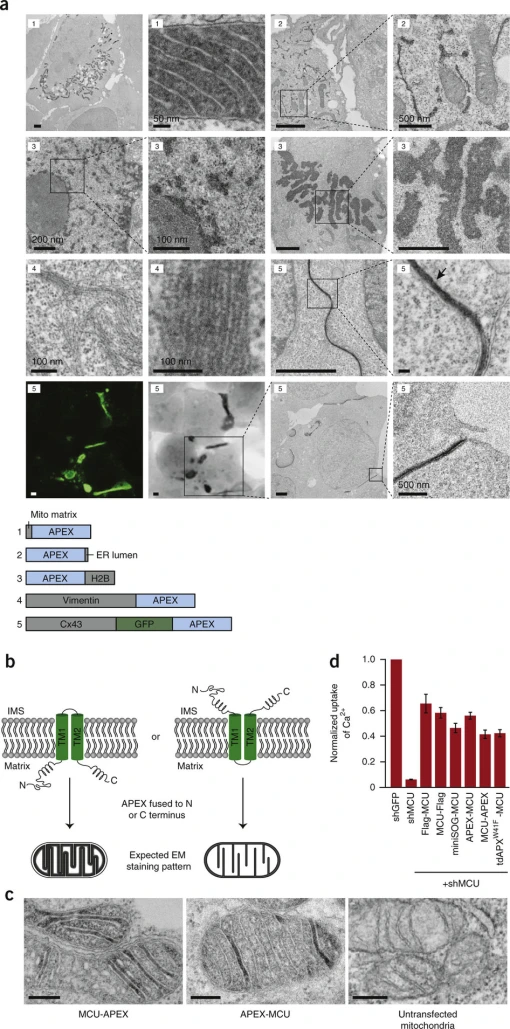Jean-Louis Bessereau – Ultrastructural mapping of functional domains of synapse at the synapse using high pressure imaging
High pressure freezing instantaneously converts up to 0.3mm thick water into amorphous ice. C Elegans only .1mm thick at maximum. HPF entire worm to obtain EM of ‘living’ synapses. Vesicle priming occurs within 100nm of presynaptic density, directly across from post receptors. However, vesicle recycling occurs only at sites >150nm lateral from presynaptic release sites.
Mark Ellisman – Multiscale light and electron microscopic imaging of the nervous system
Two-color correlated light and EM microscopy using FlAsH and ReAsH. Quantum dot immunohistochemistry for multicolor correlated light and EM. QDs of different wavelength are differently sized and can be distinguished on EM.
Eric Betzig – Superresolution optical location of single proteins.
Sparsely photoactivate PA-GFP tagged proteins with very weak laser pulse. Then image with high laser power to collect light from many point sources. Determine point source centers, then repeat process many times to find protein locations to 2-25nm resolution. See the science 2006 paper.
Winfried Denk – Automated circuit reconstruction
EM :
When doing automated serial EM, individual sections can get lost or crumpled before being imaged. Instead image the block face then shave off a section. Resolution is significantly degraded, because lower power 3keV to limit z-penetration. Penetration goes as E^(5/3). Monte Carlo simulation of backscatter at 3 vs 10keV to determine point spreads and depth. Do 30nm sections, which is very [pun alert] cutting edge. Circuit reconstruction fidelity is limited by the dimension of least resolution, so usually Z section thickness. Block face EM actually used in the 1940s. Can still identify synaptic densities. Use backscatter to see heavy things. Constructing whole c. elegans. Demonstrate by hand reconstruction of some axons, dendrites and synapses as proof of principal. Using ion gun to acquire without need of a vacuum.
Staining Technology :
Colloidal lanthanum greatly enhances contrast of extracellular space but poor tissue penetration. Kevin Briggman and Denk like using extracellular HRP currently. Good membrane contrast. Moritz Helmstadter working on automated segmentation, collaborating with Sebastian Seung @ MIT for neural network based methods. Neural network method looks pretty good.
Lukyanov – New fluorescent proteins
Cloned the first RFP from coral, DsRed. DsRed tends to aggregate due to tetramer nature. Comparison of DsRed2, TurboRFP, TagRFP and mCherry. Brightness by e*QY. 100,172,134,44 respectively. TagRFP has shorter emission wavelength (<600nm) than mCherry (618nm). Can distinguish TagRFP from mCherry by the significantly difference in lifetime. [What about mCherry2?]
Redshifted FPs.
Katusha excitation 588, em 635. QY 0.34 e 45,000. Not quite as redshifted as mPlum but significantly brighter. But not monomeric. Made mKate which has similar brightness but is monomeric.
Cyan to green photoswitchable PS-CFP. Also made Dendra, monomeric green to red photoconvertible FP. [How much bleaching to red occurs to get 90% conversion? In our hands no photoswitchable protein allows total conversion without significant bleaching.]
Visualization of targent protein degredation in real time at single cell level using Dendra2. Zhang Biotechniques Apr 2007. IkBa-Dendra2 degredation down to 20% at 5hr with cycloheximide treatment. Fluoresence stays fixed with proteasome inhibitor. 20min protein halflife following PMA treatment. Hydrogen peroxide sensor HyPer of cpYFP inserted into OxyR-RD. OxyR transcription factor forms reversible S-S bonds in bacteria. Around 2-fold ratio change 490/410 between 0 and 250nM H2O2. Showed some small responses in cells to EGF stimulation. [Is this response reversible? Never showed a recovery trace.] cpCitrine145 with m13 on N, calmodulin on C term makes a GCaMP like sensor, 12-16x maximum ratio change. [How EXACTLY is this sensor different from GCaMP2?]
Killer Red, genetically encoded photosensitizer. Screened different natural FPs for phototoxic proteins that kill bacterial colonies under light. Most FPs non-toxic, 2-5fold increase in bacterial phototoxicity, but 1 FP had 1000x increase. In mammlian cells, expression in cytosol is not enough to cause sufficient oxidative stress to kill cell with light. But target to mitochondria and can kill cells with light. Targeted to cell membrane, blebs occur in 3 minutes. Use to kill off specific muscle cell with light in zebrafish. CALI of phospholipase C1-d PH domain by fusion to killer red. However it is still dimeric, so doesn’t fuse well to some things.
Karel Svoboda – Meeting Summary
Many spatial and timescales of neural questions require development of variety techniques. Interface of new imaging techs and genetically targeted probes making lots of progress on addressing these questions. The developmental talks were some of the best applications of the new technologies. These meetings will be measured by the crystallization of new, unexpected directions in research. Of course GECIs have been very exciting, but in the last 2 years also seen big progress on…
EM
-sectioning and data collection, segmentation and reconstruction, EM on targeted neurons.
Light based approaches
– PALM, STED –EM type resolution in far field optical microscope, spectral multi-plexing, synapse specific tracing.
Optical remote control with light.
ChR2 – The silver bullet
HR – hyperpolarlize
Rhodopsin – seconds time-scale modulation of plasticity
Optical switches without transgenes
Applications
See you in 2009!





Recent Comments